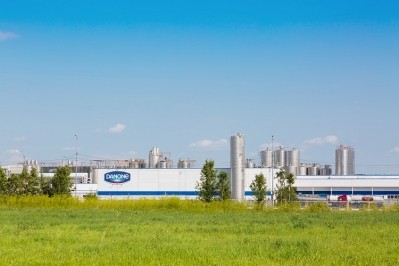Danone talks regenerative agriculture: Linking dairy and plant-based at a farm level can yield sustainability gains

Around 60% of Danone’s emissions are produced in its agricultural commodities supply chain, the company revealed in 2017 when it set out its stall focusing on regenerative practices as part of its climate action ambition.
The move came in support of Danone’s climate change commitments. The French group announced back in 2015 that it is working to make its full value chain carbon neutral by 2050. Within this journey, Danone has pledged ‘ambitious targets’ for 2030: to reduce full scope emission intensity by 50% and to achieve a 30% absolute reduction of scope 1 and 2 emissions.
Regenerative agriculture is an important part of that vision for the French Alpro-to-Activia maker.
Typically, regenerative agriculture incorporates practices like cover cropping, no till methods, crop rotation, mixed farming, and hedgerows to support biodiversity. In its grandest sense, regenerative agriculture can be used to take carbon out of the atmosphere and return it to the soil. Over a longer timeframe, this delivers results not only in terms of tackling atmospheric CO2 but also improves soil health and productivity through carbon sequestration, with the potential to reduce reliance on chemical fertilisers.
For Danone, regenerative ag is a set of practices that can ‘help regenerate the farming system’, vice president of agricultural procurement Yann-Gaël Rio told us. These are detailed in the company’s Regenerative Agriculture Scorecard to ensure transparency.
Danone’s three pillars of regenerative ag
The company’s approach is based on three pillars: planetary health, animal health, and farmer livelihoods. “The choice we have made to convert to regenerative agriculture is really about support for a better planet, support for better livelihoods for farmers and animal welfare,” he explained.
This represents something of a virtuous cycle. The positive impact of regenerative practices can be seen in improved soil health, increased biodiversity and better water quality as well as reduced water requirements. As soil health is built, productivity rises, and farms require fewer chemical inputs such as fertilisers.

“Everything we do with no till, with cover cropping, with crop rotation, with support of biodiversity through hedges and wildlife boxes, this is all helping the resilience of the crop itself. As a consequence, this reduces the need for chemical inputs,” Rio observed.
“We need to look at it as a system. Moving the entire system has many different benefits. It is going to have benefits on the chemical input reduction and water usage reduction because a better soil structure means better water holding capacity. You have many positive side effects to all the basic regenerative ag practices.”
Likewise, improved animal welfare – a positive outcome in itself – also has the side-effect of boosting productivity. “Good animal welfare means good animal health. With good animal health, you've got better yields, you've got better productivity. There is a clear link between animal welfare and on-farm performance.”
The third pillar of Danone’s approach is farmers and what the company calls ‘farming for generations’, with the aim of ensuring farmer resilience, improved livelihoods and ‘the transition from generation-to-generation’.
To support changes to the agricultural system, it is ‘essential’ to have an interconnected approach that includes social and environmental outcomes, Rio stressed.
"Nothing will change without the farmers. It's all about changing farming practices, how farmers can and are able and willing to change farming practices and the farming system. In our mind it all starts with the farmer.”
An important way that Danone supports farmers to make this long-term transition is through pricing visibility and, where appropriate, premiums.
“It’s about giving them visibility. It's about long-term contracts. Typically, when you switch to regenerative agriculture it takes 3-4 years to reap the benefits of the new system. They need visibility to engage in such a long transition.”
This visibility also comes in the form of fixed pricing or the guarantee of a pricing floor that will insulate farmers from the risk of a market crash.
“We have a third pricing mechanism where we either pay a premium for a specific farming practice implementation or we guarantee a margin of cost. Depending on the supply chain, depending on the nature of the transformation and the risk implied for the farmers, we can apply different pricing mechanisms.”
Transitioning the system: long and short supply chains
The strategy that Danone employs to engage farmers depends on whether they are part of the company’s long or short supply chains, to ‘oversimplify’ the subject, Rio explained.
“The short supply chains are either close to home - so the farmers are next to our factories - or are at arm’s length, our tier one or two suppliers. This is typically the case for dairy, plant-based milks, fruits and vegetables.
“In that case, we either buy directly from our farmers, we source directly from 50,000 farmers across the globe. Or we buy from cooperatives so the farmer is close enough so we know them, and talk to them, and promote changed farming practices while ensuring our pricing mechanism supports adoption.”
The sourcing and agriculture VP estimates that fresh milk – which is sourced directly – accounts for around 50% of the company’s ag procurement. Plant-based fruits and vegetables represent another 20-to-25% of sourcing, also purchased through the short supply chain. That leaves up to 25% of commodities sourced through longer, more complex supply chains.
"In the complex supply chain, farmers can be three, four, five steps up the chain. It is much more complicated to really know each individual farmer. We know where what we buy comes from - the country or the region - we can even know the city or village - but we don't know the individual farmer.”
How does Danone promote regenerative agriculture in these circumstances?
“Our ability to influence a change of behaviour is very different for this type of supply chain. We need to have a pre-competitive approach and leverage peer companies who have the same interest as us when it comes to transforming the supply chain. This happens through alliances of peers,” Rio observed.
Ag science and tech ‘rapidly evolving’
While many regenerative practices sound like a back to basics approach typical of the food system before the intensification and industrialisation of agriculture, Rio believes developments in science and technology will play an important role in the future of a regenerative food and farming system.
“You have a lot of natural based solutions coming out of science today which are harvesting the power of nature, selecting microbes, algae, yeast, to support plant-growth and soil health. For me there is a sweet spot where science helps identify natural-based solutions and puts it to work in the soil or on the crop,” he told us.
Precision agriculture, artificial intelligence and technologies that leverage on-farm data or predictive analytics are also developing at a rapid clip. This can help improve farming practices by reducing or targeting inputs, monitoring crop development, soil moisture or climactic conditions. “There is a lot happening here which is very helpful,” Rio said.
“These two pieces - ag science and ag tech - are developing very fast. There are a lot of innovative companies that are and will be part of the solution. We don't have all of the technical solutions posed by a transition to regenerative agriculture today. Ag science and ag tech are going to play a major role.”
Plant and animal agriculture as part of climate solution
Animal agriculture is frequently singled out for its contribution to greenhouse gas emissions. According to the FAO, animal agriculture is responsible for 14% of global emissions. If 10% of the population switched to plant-based alternatives 176 million tonnes of CO2 emissions could be avoided, according to one recent study conducted by Blue Horizon and PwC.

However, a systems-thinking approach to food production leaves space for dairy to exist as part of a sustainable whole, according to the assessment of the dairy giant – which also boasts a sizeable plant-based business.
As part of its 2050 commitments, Danone believes that it can and will get to net zero dairy production. However, offsetting and insetting will be part of this equation, Rio explained.
“The carbon neutral dairy farm will happen through improvements of farm operations to reduce the footprint - and at the same time with an offsetting or insetting strategy,” he told us.
Interestingly, Danone sees opportunity to link insetting back to regenerative practices, with animal manure used to build soil health in local ecosystems.
“When you improve soil health you improve carbon sequestration in soil which doesn't reduce the carbon emissions further on the dairy farm itself but compensates by capturing the carbon in the soil. This is the type of mixed approach we are looking at.”
Rio pointed to partnerships between local farms that see dairies purchasing feed and fodder from their neighbours and supplying them with manure to fertilise fields. In eastern France, the company has already committed to sourcing 100% French feed. These farms are ‘part of the same system’ and while the approach is not yet optimised he believes there is scope to extend such partnerships.
Rio elaborated: “It is really about taking a system approach and looking at it as a whole… We need to ensure that partnership, whether it is on the same farm or across a complex of neighbouring farms, will be improved and optimised. It is part of how we are going to keep improving our footprint.”
Integrating Danone’s dairy procurement with its plant-based sourcing is an area that Rio sees great opportunity for this kind of joined-up approach to deliver impact. "We are trying to get our dairy farmers to also supply us with plant-based commodities - soy, oat – which are very easy to inject in a rotation.
“A good crop rotation in a regenerative ag system is important because you need a legume in the rotation. We are trying to connect our plant-based business with our dairy business at farm level. This takes time but we are already doing this in Poland, where our dairy farmers started to grow oats last year, and in the US, where our dairy farmers have started to grow soy and oat.
“This is the best way to harness the best of both worlds and really develop an integrated farming system.”
Regenerative ag is just one of the opportunities we'll be probing at our upcoming broadcast event, Climate Smart Food. We'll be discussing a variety of issues, from sustainable sourcing, to sustainable consumption and food and ag tech that will support systems transformation.
With the food system contributing around one-quarter of greenhouse gas emissions today, it is clear that business-as-usual is not an option. So what needs to change if we are to transition towards truly sustainable nutrition? Join us to find out.
To register for free, click HERE, or to view details of our full programme, click HERE.





















